When most folks think of the Axis powers in World War II, they think of Germany, Italy, and Japan. While these were certainly the dominant countries, we shouldn’t let them completely overshadow the smaller countries that were their allies, like Hungary, Romania, Bulgaria, and others. These countries often used some unusual weaponry that has become pretty well forgotten over the decades. Take, for example, the Romanian Orita submachine gun.
As WWII began, the Romanian Army used primarily Mauser rifles and ZB-30 light machine guns, along with a wide variety of different submachine guns. It was decided that a domestic SMG design was necessary, and by 1941 a gun had been designed at the state arsenal at Cugir (the same arsenal that produced the thousands of Romanian AK rifles was saw imported into the US in past years) by Nicolae Sterca and Leopold Jaska. The gun was named the Model 1941 Orita, after Captain Orita, another engineer who worked on the project.
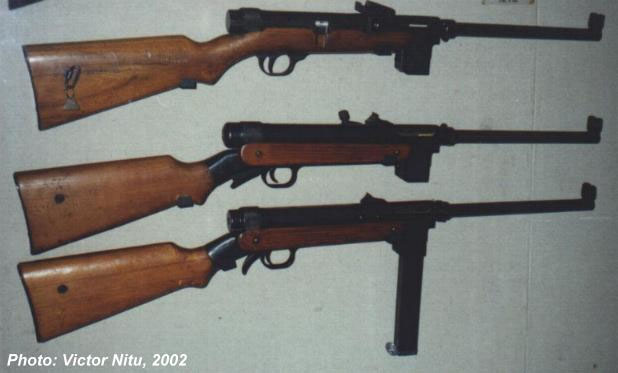
Although the Orita has the look of a stamped second-generation SMG like the MP41, it was actually much more like the precisely machined first generation of subguns. The receiver is a milled piece, and the gun is a sturdy and durable piece of kit.
Mechanics
The Orita fires from an open bolt, but it is a bit more complex in design than the typical open bolt gun. Instead of having a fixed firing pin, it uses a floating pin and lever system to fire. A projection on the front of the bolt slides backwards when it hits the barrel face, which forces a lever inside the bolt to rotate around a pivot point and strike the firing pin, which then hits the cartridge primer. This system is certainly more complex to manufacture than a simple fixed firing pin, but it prevents the possibility of an out of battery detonation. It is relevant to note, however, that this will not prevent accidental discharge as is possible with many open-bolt guns. If the bolt is closed over a loaded magazine and the stock struck against the ground, it is possible for the bolt the bounce back far enough to pick up a round form the magazine, which it will proceed to chamber and immediately fire.
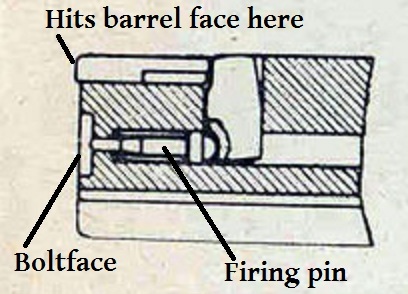
Beyond this, the mechanics of the Orita are pretty standard. It used a non-reciprocating charging handle on the left side of the gun. The magazine was a double stack, single feed type that held 32 rounds and was pretty similar in appearance (though not interchangeable with) to the MP40/41 magazines that were also in use by Romanian forces. The Orita mags can be distinguished by the deep guide grooves in both sides, which extend all the way up to the feed lips. The single-feed aspect meant that the mags were difficult to load by hand, and an interesting rotary loading tool was designed to go along with them.
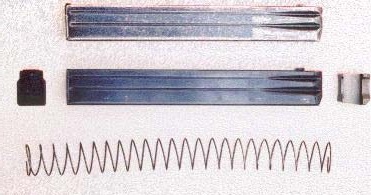
Variations
The first production version of the Orita had a number of relatively expensive features characteristic of early SMGs. The rear sight was a tangent type graduated from 100m out to 500m, and it had a crossbolt-type safety and a semi/full fire selector above the trigger. After the end of WWII the design was simplified, and fire selector was removed, making the trigger mechanism full auto only (with single shots to be made by trigger control on the part of the shooter). In addition, the manual safety was replaced by a grip safety on the underside of the wrist of the stock, and the rear sight was replaced by a simple two-position notch.
There were clearly some iterations between these two standards as well, as some photos show a grip safety and normal foreend (as below), while others show a metal wrist built into the receiver and wood panels added to the sides for a gripping surface (as in the two late model guns in the top photo). This might be explained by a combination of converted early guns and later guns built from scratch as second variants.
There are many brief references to a folding-stock version, but I have been unable to find any photos or firsthand evidence of these. If they were made, it would have been is quite small numbers.
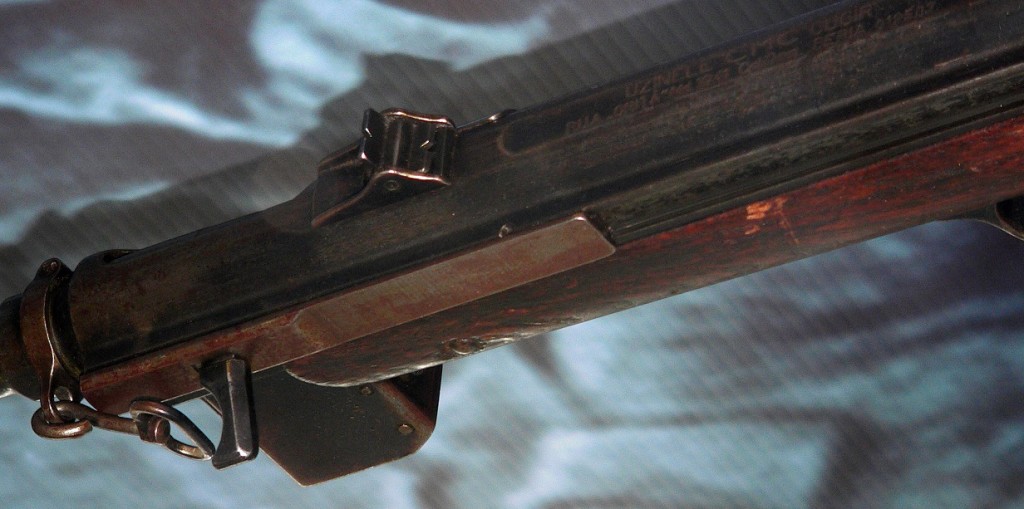
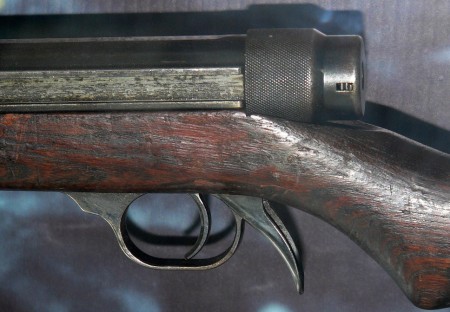
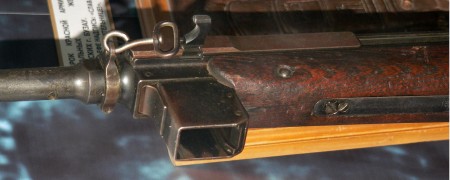
Usage
Ultimately, domestic production of the Orita could not keep up with the demand for submachine guns by the military, and Romania continued to use a wide variety of captured and purchased guns from other countries, including the MP41, ZK383, PPSh-41, Beretta M38A, and others. I found one reference to a total production of 4000 Oritas, but have not been able to confirm this.
The guns, while expensive to make, were pretty good in the field. After WW2 they continued to be used by the military well into the 1950s, and as late as the 1970s by national guard units. Eventually they were all replaced by AK rifles.
Technical Specs
Caliber: 9×19 mm
Mechanism: Plain blowback (unlocked)
Overall length: 35.2in (894mm)
Barrel length: 10.9in (278mm)
Sight Radius: 16.6in (422mm)
Sights: 100-500m tangent (early model) and two-position notch (late model)
Rifling: 6 groove, right-handed
Weight, empty: 7.6lb (3.45 kg)
Magazine capacity: 32 rounds
Rate of fire: 600 rpm
Additional Resources:
Liviu Plavcan has written the most detailed current article on the Orita: Romanian Firepower: 9mm Orita Model 1941 Submachine Gun
Yuri Pasholok has a series high resolution photos of a late model Orita, which show a lot of detail of the exterior: Orita SMG Walk Around

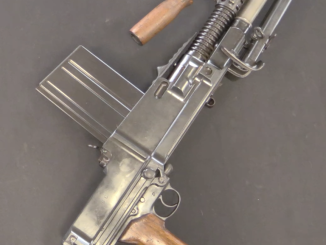
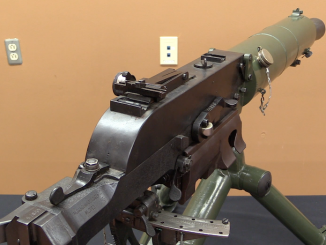
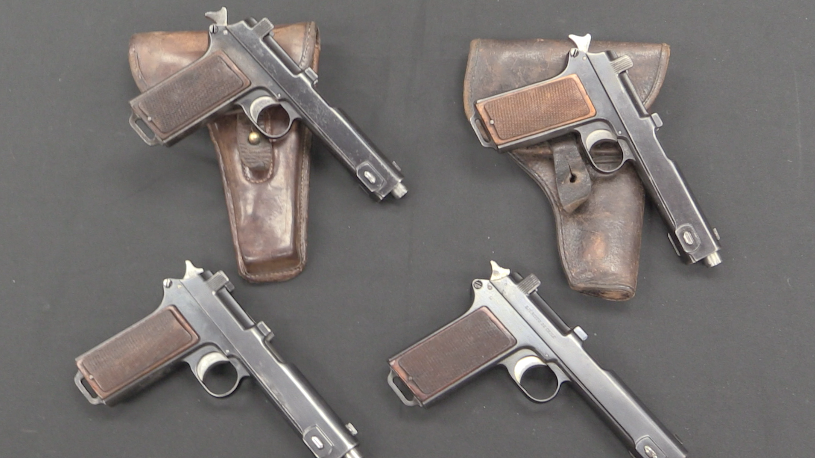
Well! Thanks!
The Orita reminds me of the Beretta M1938/49 and other SMG’s of the period — Accurate and completely reliable with a really solid, durable, precise high-quality construction and an attention to fit and finish that would be lacking in later guns due to the exigencies of war. Has anyone here owned or at least fired an Orita? If so, what are your impressions of it from a user’s standpoint?
Well written narrative by Mr.Plavkan states that single stack feed magazine can be “harder to load” but did not explain why it was made so. In comparison Beretta M38 which may have been model to Orita had much easier to handle and common magazine design . This weapon (M38)was also noted for its high reliability. Those of single stack feed mags such as Sten had preponderance to feed failure; Orita might have been exception in that sense. Any more record on that?
What a beautiful submachine gun!
Single column mags are harder to load because you must press the round down and back and the spring tension must be higher to get the rounds down the bottleneck. I could be wrong on that last point, but it seems to be the case.
In a double feed, you just stuff rounds in.
Cyrus, I think you’re right about the higher spring tension — the greater spring tension is needed to push the rounds past the tapered bottleneck at the top of the magazine where the two rows of cartridges merge into a single stack when the gun is being fed during the the firing cycle. A consequence of this is, of course, the need to push down harder on each round against that spring tension when loading the magazine.
Yes, and as Earl says too, it is more difficult way which we see commonly with pistols. There it is necesity because of constraints put on slide width; this should not be case with SMG where is generally lot more room. I wonder if anybody will be able to explain why this is the case with Orita. Much the same applies for early Stens.
Initially, my comment was going to be on the design of the bolt. But after reading what was said above about the magazine, it got me thinking. Here is what I came up with.
I think the single-position feed magazine was derived from the Bergmann designs. Since the Bergmann was one of the most reliable of the early submachine guns, the designers of later guns with vertical magazines (the Orita, MP40, M3 Greasegun, possibly others I am forgetting) most likely just copied the magazine design without thinking about why it was designed that way in the first place. Since the Bergmann feeds from the side, it cannot use a double-position feed magazine because what would be the lower round in the magazine would not be properly supported while the bolt closes on it. It would simply fall below the bolt face and jam just below the chamber. With the single-position feed magazine, the top round is properly positioned for reliable feeding in the horizontal plane.
Getting back to my original point, the lever-actuated firing pin of the Orita works exactly the same as the Thompson’s firing pin. I wonder if the designers of the Orita got their inspiration from there?
No, I don’t think that’s the reason.
The STEN also feeds from the side, but uses a two-position feed magazine.
ISTR reading that single-position feed allows a shorter feed ramp, but I can’t quite remember where.
I thought the Sten used a double-row magazine, but with single-stack feed at the top where the cartridges merged into a single vertical row courtesy of the magazine wall taper? That would explain why it was still able to feed properly from a side-mounted magazine with double-row primary storage capacity — when it was working as intended. From what I understand, a lot of the early problems with the Sten stemmed from this magazine feed system, which required a stronger spring and resulted in a lot of stress on the magazine side walls where the taper was situated, as well as added stresses on the magazine feed lips, which also made them more suspect to externally-induced damage from rough handling. Big Al may be correct in his analysis, after all.
Your second paragraph about the single-stack feed accommodating a shorter feed ramp makes sense ; it might be quite interesting to explore this technical topic a little further. Thanks!
Precisely so! I cannot recollect where and if change to double stack was introduced on Stens, but early designs incl. Mk3 were done in this manner. And they loved to jam… proofs abound.
Big Al seem to have good point in sense that designers ‘patterned’ (intended as more respectful for coppied) their design from Bergmann. However as I pointed out earlier, the Beretta used lot more modern concept, at about same time. What should be also mentioned is that the follower of Sten, being Sterling (Patchet) was already feeding from double row and had magazine mounted flat on side. Interesting, ins’t it?
The STEN does in fact use a single-position feed magazine. Here is a link to a pic (STEN mag on the right,Uzi mag on the left): http://img.photobucket.com/albums/v632/GarrettJ/Uzi/103_5726.jpg
After further thought on the matter, I have another theory. The development of the single-position feed box magazine might have to do with the fact that the MP18 originally used the Trommel Magazine ’08 which was originally developed for the Luger (and we all know what the Luger’s magazine looks like). Since conversion of that design to a box magazine with a double-position feed would require a lot of redesign on the bolt and feedway, it is plausible that Schmeisser designed the new box magazines with a single-position feed as a short-cut.
That’s a very distinct possibility, among others. Big Al, thanks for thinking this through and sharing your thoughts — it’s opened up some new ideas for discussion.
To repeat Earl,
I think you probably have it there Al.
IIRC the STEN mag was a clone of one of the German mags, manufactured to one of Schmieser’s patents, with the un-interupted mag box, and the various cut outs for catches and stops in a reinforcing sleeve which extends up to form the feed lips too. I’ll see if I can find the patent number over the next couple of days.
Certainly, if Luger mags were the starting point, then it is logical that the single feed position continued after that, to utilize the same feed cutouts and lug on the bolt, and the narrow feed ramp, but obviously changing the mag housing to one squarer to the bore.
The continuation of such standards – once established, is legendary;
most railways in the world use 4′ 8 1/2″ track guage.
This came from the Stephensons use of the same guage as the colliery tramways around Newcastle on tyne, for their steam locomotives…
The guage of the tramways came from the traditional width of a horse cart.
Horse carts were built to match the rut spacing on the British roads
those ruts had been made by Roman Chariots
I don’t know where the Romans got their standard from.
Keith, that’s a very good illustration of cause-and-effect continuity, for want of a better term — after all, if it seemed to work before, and seems to work now, why not keep up with the same? 🙂
Denny also correctly points out that Patchett used a horizontal double feed position mag for his Sterling SMG.
One of Patchett’s nice touches in his Sterling mag, is the use of a pair of rollers in the follower, so that the rounds all roll up inside the mag, rather than partially roll and partly skid.
It appears that rolling rounda are able to roll over grit and obtructions with less spring pressure behind them, than it takes to get them to skid over it.
Again, I’ll see if I can find Patchett’s patent number.
Argh, sorry, I managed to mix up left and right 🙁
(in a comparison pic of Sten and Sterling magazines)
Patent for the Scmeisser mag copied for the STEN
http://worldwide.espacenet.com/publicationDetails/originalDocument?CC=US&NR=1833862A&KC=A&FT=D&ND=3&date=19311124&DB=EPODOC&locale=en_EP
Hi, Denny :
Glad to hear from you and grateful to share in your knowledge — You brought up the topic of ( successful and reliable ) side-feeding in the Sterling-Patchett SMG from a double-row box magazine ; I think the Sterling-Patchett design incorporated a lot of hard-won lessons from the Sten and other earlier experiences, and had rollers in the magazine to reduce friction and facilitate smoother feeding of the cartridges into the breech. Also, the magazine had a slight curvatuire in it, not only to accommodate a 34-round capacity while still maintaining a reasonable magazine length, but also probably to account for the very slight taper in the 9mm x 19 Parabellum cartridge so that it would feed more reliably.
we were writing the same thing at the same time
Hi Earl,
The Schmieser mags and the STEN copies of them, have a taper towards the front of the mag box to force the tapered cases into full contact along their lengths, so that the pressure from the follower can act through the full mag to prevent the top round from dropping its front end down.
When I try to think of the rounds in such a mag rolling as they travel up it – it all gets a bit complicated
I think the reason for Patchett’s sterling mags being curved, is to allow a natural path for the very tapered 9mmp cases to roll, while retaining full contact from head to mouth, so that the round in the feed lip, can’t wobble.
Here’s Patchett’s patent for the roller follower mag
http://worldwide.espacenet.com/publicationDetails/originalDocument?CC=US&NR=2510831A&KC=A&FT=D&ND=3&date=19500606&DB=EPODOC&locale=en_EP
and a later Patchett patent to allow the use of an easier and cheaper to make, circular section coil spring in a curved mag with his roller follower.
http://worldwide.espacenet.com/publicationDetails/originalDocument?CC=US&NR=2795880A&KC=A&FT=D&ND=3&date=19570618&DB=EPODOC&locale=en_EP
That’s a really interesting patent, Keith — thanks! I think Patchett was not only very talented but also greatly under-rated and insufficiently recognized for his achievements in many ways.
Just as an aside
The particularly large Steyr GB pistol, uses a mag which feeds from both sides.
It was a real pleasure to load. I’ve had some nasty cuts on the pads of my thumbs from loading single feed position mags that had sharp edges, so I’m always cautious with them now. Just being able to shove the rounds in was a treat.
Going back a few days top Ian’s video of the Roth Steyr
It was interesting to see the movable block which formed one of its feed lips
movable to allow stripper feeding a single column mag.
The striker is interesting.
I suppose it is debatable whether a SMG is actually using advance primer ignition, in which it fires the round with the bolt still travelling forward – thus allowing the use of a bolt of half the weight required for ordinary blowback
as the recoil must first overcome the forward momentum of the bolt, before accelerating it backwards.
Or whether the worries of a hang fire, and the problems of tolerances, mean that it is usually operated as a plain blowback, with a bolt heavy enough to prevent the case head from emerging from the chamber and bursting, if there were a hang fire…
Guns which really do use advance primer ignition, such as the Becker cannon and the subsequent Oerlikons and developments of Becker type cannons from them,
use a similar (more complex) form of striker to ensure that the primer is struch at the correct point in the bolt’s forward travel.
The Spanish Star Z62 and Z70 SMGs used a similar striker set-up to the Orita, but with the addition of an inertia lock, to prevent the bolt from going back if the gun recieved a jolt with the bolt forward and a full mag in place. It’s shown on page 8 of the French patent application here:
http://worldwide.espacenet.com/publicationDetails/originalDocument?CC=FR&NR=1405239A&KC=A&FT=D&ND=3&date=19650709&DB=worldwide.espacenet.com&locale=en_EP
Again (it’s just turned 1 am here) I’ll try to look out the star, becker an Oerlikon patents in English.
Keith,
As I said in my first post earlier up the page, the Thompson was the first design to use a lever-actuated firing pin to strike the primer only when the bolt is fully in battery.
Here is a cutaway of an M1928: http://www.kiwimodeller.com/~kmodel/media/kunena/attachments/385/ThompsonM1928USACutaway.jpeg
Under the cocking handle, you can see the pivoting lever that strikes the firing pin when the bolt returns to battery. What is not readily apparent is that there is a ‘bulkhead’ of sorts separating the rear portion of the bolt from the area where the magazine enters the receiver. It is this partition that the lever strikes to fire the cartridge. It is essentially identical to the Orita’s bolt in principal and function.
The first of the patent refs:
Becker’s 1915 patent for the advance primer ignition cannon, the rights to which were acquired and developed after WW1 and German disarmament, by Oerlikon in Switzerland.
http://worldwide.espacenet.com/publicationDetails/originalDocument?CC=US&NR=1144285A&KC=A&FT=D&ND=3&date=19150622&DB=EPODOC&locale=en_EP
In Becker /Oerlikon cannons operating with advance primer ignition, the primer is struck about an inch before the bolt reaches its full forward travel, so some means of achieving this reliably is needed – and in the case of the Becker, the means is very simillar to the striker later used by Orita.
Later development and experience by Oerlikon, showed that if the tripping lever broke, then the inertia of the striker could still cause a slam fire when the bolt impacted on the breech, firing the round an inch to far forward, and when the forward momentum of the bolt had already been exhausted. the result of this would likely be a ruptured or at least separated case, and a very severe recoil blow as the bolt recoiling at twice normal speed, hit the rear of its travel.
Elgin’s 1942 Swiss patent (US Patent 2,512,014 ) assigned to Oerlikon, provides a tripping lever which retracts the striker again with further forward travel, preventing it from being able to cause a slam fire if the part for firing the round breaks off.
The effectively fixed striker of the Schmieser designs, which was further simplified into a protrusion of the bolt in many of the WWII designs (I’m not sure who that was – Shepherd and Turpin? or earlier?) gave less than the strikers length of forward travel remaining for the bolt before it bounced off the breech face – but with the full diameter case head of the typical SMG rounds, compared to the drastically rebated rim of the API cannon rounds, there isnt room for anything more.
Thanks, Keith. I was unaware of that.
Hi Al,
Sorry, it was into the wee small hours of this morning when I was typing the first comments and the prospect of going rummaging for patent numbers didn’t appeal. Normally I wouldn’t have been quite that lazy(with heavy emphasis on the “quite”) and the question would never have arisen. my bad.
To be honest, I’d forgotten all about the Thompson, so thanks for the reminder and the cross section.
even without drawings of the innards, it looks like the Orita’s (and the later Star guns) striker has taken a leap forward from the Becker and Thompson.
by activating it from impact with the breech face of the barrel, barrel position relatibve to the length of the receiver tube, becomes much less critical
with the Thompson, the distance from the “firewall” (for want of a better name) and the breech face of the barrel becomes important, as does the position of the pivot hole for the see-saw tripping leaver.
The Orita is clearly not designed with ease of manufacture in mind (a tubular receiver which could so easily have been a cheap length of tube, but it then gets the raceway down one side for the cocking handle – so the whole thing needs to be made with multiple milling operations…) but that striker set up is clever.
It would be interesting to see the Orita’s bolt face, to see whether it is has a rim all around the counterbore for the case head, or whether that retractable striker was to allow the lower part of that bolt face rim to be cut away al- la Mauser controlled feed
as with such a feed set up, a fixed firing pin would get in the way.
with a counterbore fully encircled by a rim, a fixed pin doesn’t get in the way, and the case is well guided by the chamber walls before a fixed pin gets near to the primer.
a link to Ian’s .PDF of an Oerlikon cannon manual
https://www.forgottenweapons.com/oerlikon-20mm-manual/
I find it slightly odd that such simple and potentially cheaply manufactured guns found niches with pistol calibre rounds, and spectacularly successfully with cannon rounds, but there is a gap in the middle for rifle rounds where it hasn’t found favour.
a link to Irusta’s US patent for the striker and inertia lock on the Star Z62 and Z70 SMGs
http://worldwide.espacenet.com/publicationDetails/originalDocument?CC=US&NR=3220135A&KC=A&FT=D&ND=3&date=19651130&DB=EPODOC&locale=en_EP
Thanks guys for all the passed on knowledge! We are maybe bit in excess of what was originally intended, but I think it is well worth of going thru.
Back to Orita – I believe that designers took (from looks of it) good care of reliable mag feeding, even with the fact that it is single position outlet.
As Denny pointed out, we may have collectively gone above and beyond the original intent of this post — yet, I cannot help but feel that nothing has been lost and much gained because the main and secondary ( spin-off ) threads such as the Sten magazine discussion all fulfill the most important intended functions of Ian’s web site, i.e., the promotion of critical thinking and the open, unselfish sharing of knowledge, for which there can never be enough thanks.
While we did go off to discussing the magazines of other guns, the Orita does use a single-position feed magazine. So all the discussion above was not a total trip in the wrong direction.
I’m glad to hear that most of us are in agreement on this — thanks, Big Al.
Bolt and firing mechanism is not unlike that of the Z45. That would be another great forgotten weapon to touch upon one of these days.
– Please read my article about the Romanian 9mm Orita M1941 submachine gun printed in the January issue of the Small Arms Review magazine, the year 2009.
I fired the 9mm Orita M1941/48 SMG in Romania in 1970s. It is an excellent WW2 weapon.
Liviu Stoica 04/24/15
– My article about the Romanian made 9mm Orita M1941 SMG can be read here at http://www.smallarmsreview.com/display.article.cfm?idarticles=1237
Liviu Stoica 04/24/15
Oriță – for English speakers is pronounced Orizzer as in pizza and no final sounding “r”.